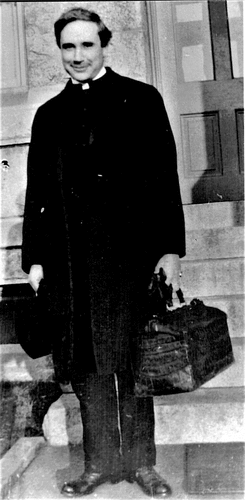Thomas Verner Moore

Fr. Thomas Verner Moore, medical bag proudly in hand, shortly after receiving his M.D. from the Johns Hopkins University Medical School on June 8, 1915. Photo courtesy of the Trinity Washington University Archives, Washington, D.C.
Thomas Verner Moore (1877–1969) of the Catholic University of America in Washington, D.C., was the first psychiatric researcher to create symptom rating scales and use factor analysis to deconstruct psychosis. “Our method is without precedent in psychiatry,” Moore correctly stated in his pioneering 1933 monograph, and its goal was “the dismemberment of the manifestations of insanity into a group of symptoms and the empirical synthesis of these symptoms by a mathematical technique” (1). Reading it today, one is struck by its modernity and the degree to which it anticipated critical issues in current psychiatric research. Moore was familiar with the latest European studies of the genetics of the major psychoses and concluded, from his own analyses, that the genetic causes of the Kraepelinian syndromes of dementia praecox (schizophrenia) and manic-depressive insanity were partially overlapping. His preliminary report of finding eight factors underlying psychotic symptoms was published in the pages of this journal in 1930 (2). No one used these methods in psychiatry again until the late 1940s (3, 4).
Moore had met the English psychologist Charles Spearman (1863–1945) in Leipzig in 1904 when working in the laboratory of Wilhelm Wundt (1832–1920) and is credited for being an early and influential proponent of Spearman’s factor analysis in the United State (5). In his study of the psychoses Moore used Spearman’s “tetrad difference technique” (1904), the first method of factor analysis ever devised. In a classic paper published in 1934, psychologist L.L. Thurstone (1887–1955) presented a reanalysis of Moore’s data to introduce and demonstrate the usefulness of his own modification of Spearman’s method, an innovation that became one of the foundations of modern factor analysis, as “a rational basis for the classification of the insanities” (6).
Moore was a polymath. He was a Roman Catholic priest (ordained 1901); an experimental psychologist (Ph.D., Catholic University, 1903) who had worked under Wundt in Leipzig in 1904 and Oswald Külpe (1862–1915) in Munich in 1913–1914; a psychiatrist (M.D., Johns Hopkins, 1915) who had worked under Emil Kraepelin (1856–1926) in Munich in 1914 and Adolf Meyer (1866–1950) in Baltimore in 1915; and (later) a hermetic Carthusian monk who spent his last years in total silence while tinkering with the application of factor analysis to the study of mystical states of consciousness (7). Between 1916 and 1918 Moore founded and operated a clinic in Washington, D.C., which treated children with nervous and mental diseases. In July 1918 he was commissioned as a captain in the neuropsychiatric division of the medical corps in the U.S. Army and served near the front lines in France during the First World War, treating many “war neuroses.” Much of his academic career before retirement in 1947 was spent at Trinity College and the Catholic University of America, both in Washington, D.C. (8).
Moore was a respected member of the American Psychiatric Association and played an important role in demonstrating the relevance of psychological methods for psychiatric research (9, 10). Between 1932 and 1935 he served on a special committee funded by the Carnegie Corporation to study the possible applications of factor analysis to identifying the basic personality traits in human nature. Headed by psychologist Edward Thorndike (1874–1949), the committee’s other members included statistician Harold Hotelling (1895–1973) and psychologists Karl Lashley (1890–1958), Clark Hull (1884–1952), and Charles Spearman. The notable achievement of their work was the development of the method of “principal components” analysis in 1933 (11, 12). This method was widely used after 1950, when Department of Veterans Affairs psychologist Maurice Lorr (1910–1998) initiated the modern era of symptom rating scales and factor analysis in psychiatric research. Lorr repeatedly acknowledged his debt to Moore in his own publications (4).
1 : The Essential Psychoses and Their Fundamental Syndromes: Studies in Psychology and Psychiatry from the Catholic University of America., vol III, number 1. Baltimore, Williams and Wilkins, 1933Google Scholar
2 : The empirical determination of certain syndromes underlying praecox and manic depressive psychoses. Am J Psychiatry 1930; 86:719–738Link, Google Scholar
3 : The Classification of Psychopathology: Neo-Kraepelinian and Quantitative Approaches. Berlin, NY, Springer, 1984Crossref, Google Scholar
4 : Syndromes of Psychosis. New York, Macmillan, 1963Google Scholar
5 : T.V. Moore’s (1939) Cognitive Psychology. Psychon Bull Rev 1997; 4:342–349Crossref, Google Scholar
6 : The vectors of mind. Psychol Rev 1934; 41:1–32Crossref, Google Scholar
7 : Thomas Verner Moore: 1877–1969. Am J Psychol 1970; 83:286–288Medline, Google Scholar
8 : Thomas Verner Moore: Psychiatrist, Educator and Monk. New York, Paulist Press, 2000Google Scholar
9 : A century of psychology in its relationship to American psychiatry, in One Hundred Years of American Psychiatry. Edited by Hall JK, Zilboorg G, Bunker HA. New York, Columbia University Press, 1944Google Scholar
10 : “One Hundred Years of American Psychiatry:” a review. Psychol Bull 1945; 42:423–432Crossref, Google Scholar
11 Parker JDA: In Search of the Person: The Historical Development of American Personality Psychology (doctoral dissertation). York, Ontario, Canada, York University, Aug 1991Google Scholar
12 : Recent research on unitary mental traits. Character Pers 1936; 4(June):334–343Google Scholar



